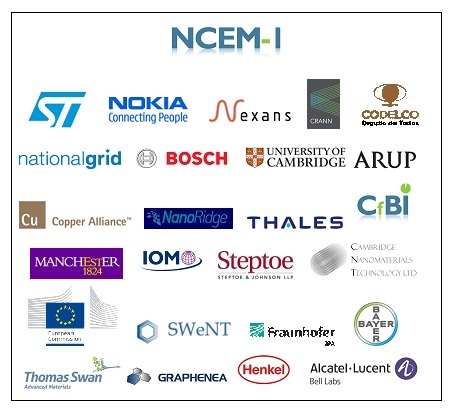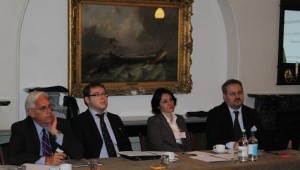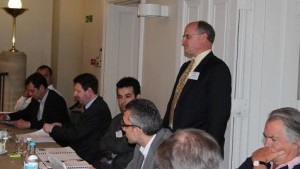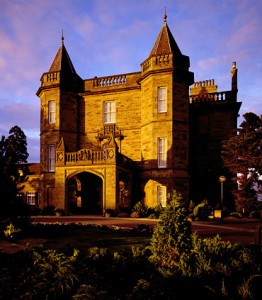Nano Carbon Enhanced Materials (NCEM) Consortium
Commercialisation of carbon nanotechnologies has the potential to drive innovative and competitive industry change by enabling key advances in many manufacturing sectors such as energy, automotive, aerospace, construction, electronics and biotechnology. The Nano-Carbon Enhanced Materials (NCEM) consortium has been put forward by the Centre for Business Innovation Ltd (www.cfbi.com) in order to provide the consortium members a unique inside into carbon nanotechnologies and an opportunity to address commercialisation challenges. The consortium leader is Dr Bojan Boskovic from Cambridge Nanomaterials Technology Ltd.
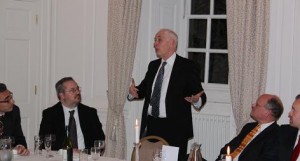
Prof. Alan Windle from University of Cambridge addressing delegates at the NCEM-1 dinner in Cambridge.
The Nano-Carbon Enhanced Materials (NCEM) consortium is an opportunity to engage with leading companies in the supply chain and leading world class experts in a commercialisation pathfinder programme for a small fraction of time and total costs of alternatives such as consultancy, meetings, workshops and conferences. The use of nano-carbon materials, such as carbon nanotubes and graphene is a rapidly evolving field and this is an opportunity to influence where it goes and how fast. The mission of the consortium is to facilitate the commercial uptake of technologies based on nano-carbon materials such as graphene and carbon nanotubes and it brings together potential users from defense, energy, electronics, structural materials, and metal industries with a shared interest in understanding the challenges and opportunities of nano-carbon disruptive technologies. The aim of the consortium is to provide discussion platform and a vehicle for action regarding collaborative R&D, supply chain building, H&S, regulatory and other issues related to commercialisation of carbon nanomaterials.
The 1st NCEM consortium (NCEM-1) launch was in April 2012 in Cambridge, UK. In five meetings of the NCEM-1 consortium, from April 2012 to April 2013, 25 organisations from 10 countries have participated by providing delegates and speakers (see logos below).
The NCEM consortium members include: University of Cambridge (UK); Nokia Research Centre (UK); ST Microelectronics (Italy); International Copper Association (USA); Nexans (France); Bosch (Germany); Codelco (Chile), Thales UK (UK), National Grid (UK), Trinity College Dublin (Ireland), Stattnet (Norway), Schneider Electric (France) and Arup (UK).
The 1st NCEM-1 (NCEM-1.1) meeting was in Downing College Cambridge, UK on 19th April 2012 with an opening dinner at Trinity Hall, Cambridge on 18th April 2012. The NCEM-1 Cambridge meeting delegates and consortium members were addressed by leading academics from University of Cambridge and experts in the field of nano-carbon materials: Prof. Bill Milne from Department of Engineering who gave presentation about nano-carbon electronics and Prof. Alan Windle and Dr. Krzysztof Koziol from Department of Materials Science and Metallurgy who presented scientific advances and commercialisation challenges related to carbon nanotube fibre technology. The NCEM-1 consortium members form Nokia Research Centre (UK) and International Copper Association also gave presentation about their vision and challenges related to commercialisation of nano-carbon technologies in mobile electronics and copper metal composite applications.
Malcolm Burwell from International Copper Association commented after the 1st NCEM consortium meeting:
“We all felt that the value obtained from the single meeting that we just had justified the yearly fees on its own.”
The 2nd NCEM-1 (NCEM-1.2) meeting has taken place in Dalmahoy Marriott Hotel and Country Club in Edinburgh, the Scottish Baronial Manor set in 1000 acres of parkland and one of Scotland’s premier golfing venues. The morning session started with the “Masterclass in NanoSafety: The health, safety and business risks in nanotechnology innovation and how they can be addressed” delivered by Dr Steve Hankin and Dr Craig Poland from the Institute of Occupational Medicine from Edinburg in Scotland. This was followed by the panel discussion. After the lunch the meeting delegates would have an opportunity to hear Dr Kyle Kissell, Director of Technology Development from NanoRidge, USA who presented recent development to incorporate highly conductive carbon nanotubes into copper metal that resulted in a composite material with superior properties, higher electrical conductivity and increased current carrying capacity, as compared to conventional copper. His presentation was followed by presentation from Dr Francesco Bonaccorso from University of Cambridge about graphene applications in electronics and an update about European FP7 NMP 2013 call for collaborative R&D proposals presented by Dr Bojan Boskovic.
Dr Kyle Kissell, Technology Development Director from NanoRidge Materials commented after the NCEM-1 meeting in Edinburgh:
“I believe that consortia like this are a critical step towards bridging the gap between extraordinary science and products commercialization. We feel privileged to be invited to speak to a group that is interested in DOING something as opposed to just TALKING about something. The connections we created during the two days of interactions will be crucial for the success of our products and our company.”
Dr Anna Gergely from Steptoe & Johnson LLP co-hosted the 3rd NCEM-1 (NCEM-1.3) meeting on 6th and 7th November in Brussels. She also presented an insight into nanomaterials related regulations in the EU at the meeting. The guest speakers were also Dr David Arthur CEO of the SWeNT in the US one of the lading SWNT producers and Dr Peter Krueger, Head of Working Group Nanotechnology, Bayer MaterialScience, Germany. Peter is also leading Inno.CNT €90M German Government supported programme about carbon nanotube commercialisation. Christos Tokamanis who is Head of Nano Sciences and Technologies at the European Commission in Brussels gave a presentation about FP7 NMP Theme and an insight into nanotechnologies and nanomaterials within a new Horizont2020.
The consortium submitted EC FP7 UltraWire project proposals in December 2012 that includes 4 consortium members and 2 of the organisations that provided speakers. The UltraWire project has been awarded a grant of €3.3M by the EC and it started on 1st October 2013.
Ivica Kolaric and his team from Fraunhofer IPA in Stuttgart were co-hosting the 4th NCEM-1 (NCEM-1.4) meeting on 27th and 28thFebruary 2013 and also provided us with an insight into carbon nanomaterials related research activities at Fraunhofer IPA including carbon nanotube metal composites and graphene supercapacitors. The NCEM-1.4 meeting delegates were given a tour of the Fraunhofer IPA laboratories. Dr Andre Zimmermann from Bosch in Stuttgart introduced Bosch Group and give presentation about potential and challenges of polymers in electronics. Jesus de la Fuente, CEO of Graphenea from San Sebastian in Spain presented graphene manufacturing activities at Graphenea. Stefano Borini from Nokia Resercah Centre in Cambridge gave a presentation of graphene technology for future portable devices and give an update of Nokia’a activities regarding graphene including Graphene Flagship programme. Dr Bojan Boskovic, NCEM Programme Director, gave an update of consortium activities including success with the EC FP7 UltraWire project proposal entering the EC negotiation stage.
Dr Chris Keely and his team and the CRANN, Trinity College Dublin were co-hosting the 5th NCEM-1 (NCEM-1.5) meeting on 15th and 16th April 2013 in Dublin and providing delegates with an insight into nano-carbon enhanced materials related research activities at the CRANN. Dr Georg Duesberg from CRANN talked about latest research in carbon based nano-structures for electronic and energy devices. Dr Ryan Enright from Alcatel Lucent Bell labs Ireland talked about role of nanoscience in advanced thermal management from ICT/Telecom perspective. Dr Andy Goodwin gave an overview of carbon nanomaterial production and research activities at Thomas Swan & Co. Mark Bowers from Arup talked about carbon nanomaterial applications in construction industry and role of Arup. Malcolm Burwell from Copper Industry Association gave an update on development of ultraconductive copper-carbon nanotube composites.
The 2nd NCEM consortium (NCEM-2) started with the first meeting (NCEM-2.1) in Nokia Research Centre in Cambridge on 10th July 2013 and an opening dinner at the Trinity Hall College on 9th July. The NCEM-2.1 Cambridge meeting co-organisers from Nokia gave presentation about Nokia Research Centre and nano-carbon related research activities including Graphene Flagship Programme. Dr Karl Coleman, CTO and Claudio Marinelli, Business Development Director from Durham Graphene Science (DGS) presented graphene manufacturing capacities, and discussed plans and opportunities for collaboration with DGS. Dr Krystof Koziol from Department of Materials Science and Metallurgy at the University of Cambridge gave an update on his research activities including information about the FP7 UltraWire project. Dr Haider Butt from Department of Engineering at the University of Cambridge gave a presentation about optical holograms based on carbon nanotubes. Adam Green from the National Grid gave an overview about National Grid and opportunities for use of nano-carbon materials in electrical energy transmission applications.
Jesús de la Fuente and his team from Grephenea were co-hosting the 2nd NCEM-2 (NCEM-2.2) meeting on 7th and 8th October 2013 in San Sebastian and also providing an insight into graphene manufacturing and research activities at Graphenea. Dr. Amaia Zurutuza, Scientific Director at Graphenea, gave presentation about graphene applications and research activities at Graphenea. Jose Luis León, General Manager IDEC.aero – Advanced Composites Manufacturer for Airbus and Airbus Military (Spain) gave a presentation about carbon nanomaterials in aerospace composites. Francis Massin, CEO of Nanocyl (Belgium) gave a presentation about carbon nanotube manufacturing, product development and research at Nanocyl, one of the leading carbon nanotube manufacturers. Dr. J. Alberto Blázquez gave a presentation about experience of CEGASA and IK4-CIDETEC (Spain) about choosing the right nano-carbon materials for battery and fuel cell applications. Dr. Teresa Álvarez Centeno from Instituto Nacional del Carbón – CSIC, Oviedo, (Spain) gave a presentation about carbon nanomaterials insupercapacitors including reflection to the work done in the FP7 ElectroGraph project regarding development of grapheme supercapacitor electrodes. Dr Virginia Ruiz from the Nanomaterials Unit, IK4-CIDETEC (Spain) gave a presentation about diversified activities on carbon nanomaterials research in their group. Schneider Electric from France was welcomed as new member of the consortium.
For further details and information how to join the consortium please contact Dr Bojan Boskovic who is a leader of the consortium: Bojan.Boskovic@cnt-ltd.co.uk or Bojan.Boskovic@cfbi.com.
You can follow the link bellow to get more information about the Nano-Carbon Enhanced Materials (NCEM) consortium on the Centre for Business Innovation Ltd website: http://www.cfbi.com/index_files/nanocarbon.htm
